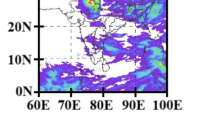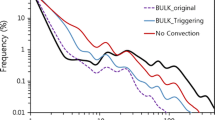Abstract
Intense rainfall often leads to floods and landslides in the Himalayan region even with rainfall amounts that are considered comparatively moderate over the plains; for example, ‘cloudbursts’, which are devastating convective phenomena producing sudden high-intensity rainfall (∼10 cm per hour) over a small area. Early prediction and warning of such severe local weather systems is crucial to mitigate societal impact arising from the accompanying flash floods. We examine a cloudburst event in the Himalayan region at Shillagarh village in the early hours of 16 July 2003. The storm lasted for less than half an hour, followed by flash floods that affected hundreds of people. We examine the fidelity of MM5 configured with multiple-nested domains (81, 27, 9 and 3 km grid-resolution) for predicting a cloudburst event with attention to horizontal resolution and the cloud microphysics parameterization. The MM5 model predicts the rainfall amount 24 hours in advance. However, the location of the cloudburst is displaced by tens of kilometers
Similar content being viewed by others
References
Bougeault P, Binder P, Bizzi A, Dirks R, Houze R, Kuettner J, Smith R B, Steinacker R and Volkert H 2001 The MAP special observing period;Bull. Amer. Meteor.Soc. 82 433–462.
Chen S-H and Lin Y-L 2001 Orographic effects on a conditionally unstable flow over an idealized three-dimensional mesoscale mountain;MAP Newsletters 15 246–249.
Das S, Johnson D and Tao W-K 1999 Single-column and cloud ensemble model simulations of TOGA-COARE convective systems;J. Met. Soc. Japan 77 803–826.
Das S, Sud Y C and Surez M J 1998 Inclusion of a prog-nostic cloud scheme with the relaxed Arakawa-Schubertcumulus parameterization: Single-column model results;Q. J. R. Meteorol. Soc. 124 2671–2692.
Das S 2002 Evaluation and verification of MM5 forecasts over the Indian region;Proc. 12th PSU/NCAR Mesoscale Model Users Workshop, Boulder, CO, NCAR, 77–81.
Dudhia J 1996 A multi-layer soil temperature model for MM5;Preprints, The Sixth PSU/NCAR Mesoscale Model Users’ Workshop, 22–24 July 1996, Boulder, Colorado, 49–50.
Grell G 1993 Prognostic evaluation of assumptions used by cumulus parameterizations;Mon. Weather Rev. 121 764–787.
Held G 1982 Comparison of radar observations of a devastating hailstorm and a cloudburst at Jan Smuts Airport; In: Cloud Dynamics; E M Agee and T Asai (eds) Advances in Earth and Planetary Sciences (Tokyo: Terra Scientific Publishing Company).
Hong S-Y and Pan H-L 1996 Nonlocal boundary layer vertical diffusion in a medium-range forecast model.Mon. Weather Rev. 124 2322–2339.
Houze R A 1993 Cloud Dynamics;International Geophysics Series. Vol. 53, Academic Press, Inc.
Kummerow, Christian, William Barnes, Toshiaki Kozu, James Shiue and Joanne Simpson 1998 The Tropical Rainfall Measuring Mission (TRMM) Sensor Package;J. Atmos. Oceanic Technol. 15 809–817.
Lin Y-L, Farley R D and Orville H D 1983 Bulk parameterization of snow field in a cloud model;J. Climate Appl. Meteor. 22 1065–1092.
Mann C F and Kuo Y-H 1998 Regional real time numerical weather prediction: Current status and future potential;Bull. Amer. Meteor. Soc. 79 253–263.
Orlanski I 1975 A rational subdivision of scales of atmospheric processes;Bull. Amer. Meteor. Soc. 56 527–530.
Paegle J, Pielke R, Dalu G, Miller W, Garratt J, Vukicevic T, Berri G and Nicolini M 1990: Predictability of flows over complex terrain; In: Atmospheric Processes over Complex Terrain, (ed.) W Bluman,Meteor. Monogr. 23 285–299.
Pielke R A 1984 Mesoscale meteorological modelling; San Diego, CA, Academic.
Rutledge S A and Hobbs P V 1984 The mesoscale and microscale structure and organizations of cloud and precipitation in midlatitude clouds. XII: A diagnostic modeling study of precipitation development in narrow cold-frontal rainbands;J. Atmos. Sci. 41 2949–2972.
Schultz P 1995 An explicit cloud physics parameterization for operational numerical weather prediction;Mon. Weather Rev. 123 3331–3343.
Smith R B 1979 The influence of mountains on the atmosphere;Adv. Geophys. 21 187–230.
Stano G, Krishnamurti T N, Vijay Kumar T S V and Arun Chakraborty 2002 Hydrometeor structure of a composite depression using the TRMM radar;Tellus 54 370–381.
Tao W-K, Simpson J and McCumber M 1989 Ice-water saturation adjustment;Mon. Weather Rev. 117 231–235.
Tao W-K, Sui C-H, Ferrier B, Lang S, Scala J, Chou M-D and Pickering K 1993 Heating, moisture and water budgets of tropical and midlatitude squall lines: comparisons and sensitivity to longwave radiation;J. Atmos. Sci. 50 673–690.200516
Author information
Authors and Affiliations
Rights and permissions
About this article
Cite this article
Das, S., Ashrit, R. & Moncrieff, M.W. Simulation of a Himalayan cloudburst event. J Earth Syst Sci 115, 299–313 (2006). https://doi.org/10.1007/BF02702044
Received:
Revised:
Accepted:
Issue Date:
DOI: https://doi.org/10.1007/BF02702044




